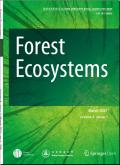Increased positive tree species mixture effects on the abundance and richness of Collembola with stand development in Canadian boreal forests
IF 3.8
1区 农林科学
Q1 FORESTRY
引用次数: 0
Abstract
It is well established that species mixtures could enhance ecosystem functioning in diverse ecosystem types, with these benefits increasing over time. However, the impact of tree mixtures on Collembola communities following stand development in natural forests remains unclear, despite the critical roles Collembola plays in litter decomposition and nutrient cycling. We investigated the effects of tree species mixtures on Collembola abundance, diversity, and community structure by sampling pure and mixed jack pine (Pinus banksiana Lamb.) and trembling aspen (Populus tremuloides Michx.) of 15-year-old and 41-year-old stands in natural boreal forest. In total, 6,620 individuals of Collembola were identified as belonging to 39 species/morphospecies. Our results showed significant effects of stand types on Collembola with higher abundance and richness in conifer and mixed stands than in broadleaf stands. Additionally, with stand development, we observed increased Collembola abundance and richness. In 15-year-old stands, Collembola abundance, richness, and evenness in mixed-species stands were comparable to those in single-species stands. However, as stands developed, tree mixture effects became more pronounced, resulting in higher Collembola abundance and richness in mixed-species stands compared to the average of single-species stands in 41-year-old stands. Further, we observed positive associations between the mixture effects on Collembola abundance and richness with soil nutrient contents. We conclude that tree species mixtures can significantly enhance Collembola abundance and diversity, particularly in older stands and those with elevated soil nutrient levels.
加拿大北方针叶林林分发展对弹桃丰度和丰富度的正向树种混合效应增加
物种混合可以增强不同生态系统类型的生态系统功能,并且这些益处随着时间的推移而增加。然而,尽管弹线虫在凋落物分解和养分循环中起着关键作用,但混交树对天然林林分发育后弹线虫群落的影响尚不清楚。摘要以北方针叶林15年生和41年生的纯针叶松(Pinus banksiana Lamb.)和混交林(Populus tremuloides Michx.)为研究对象,研究了树种混交林对炭黑种群丰度、多样性和群落结构的影响。共鉴定弹虫6620只,隶属于39种/形态种。结果表明,林分类型对弹珠线虫的影响显著,针叶林和混交林弹珠线虫的丰度和丰富度高于阔叶林。此外,随着林分的发育,弹线虫的丰度和丰富度都有所增加。在15年林分中,混种林分中弹虫的丰度、丰富度和均匀度与单种林分相当。随着林分的发展,混树效应更加明显,混种林分中弹线虫的丰度和丰富度高于41年林分中单种林分的平均值。此外,我们观察到混合效应对弹线虫丰度和丰富度的影响与土壤养分含量呈正相关。结果表明,树种混交能显著提高弹线虫的丰度和多样性,特别是在老林分和土壤养分水平较高的林分。
本文章由计算机程序翻译,如有差异,请以英文原文为准。
求助全文
约1分钟内获得全文
求助全文
来源期刊

Forest Ecosystems
Environmental Science-Nature and Landscape Conservation
CiteScore
7.10
自引率
4.90%
发文量
1115
审稿时长
22 days
期刊介绍:
Forest Ecosystems is an open access, peer-reviewed journal publishing scientific communications from any discipline that can provide interesting contributions about the structure and dynamics of "natural" and "domesticated" forest ecosystems, and their services to people. The journal welcomes innovative science as well as application oriented work that will enhance understanding of woody plant communities. Very specific studies are welcome if they are part of a thematic series that provides some holistic perspective that is of general interest.
 求助内容:
求助内容: 应助结果提醒方式:
应助结果提醒方式:


